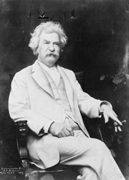William Joseph Long was an American writer, naturalist and minister. He lived and worked in Stamford, Connecticut.

As a naturalist, he would leave Stamford every March, often with his two daughters Lois and Cesca, to travel to ‘the wilderness’ of Maine. William Long believed that the best way to experience the wild was to plant yourself and sit for hours on end to let the wild creatures “come to you; and they will!”
They would stay in the wilderness until the first snows of October, although sometimes he would stay all winter. In the 1920s, he began spending his summers in Nova Scotia, claiming “the wilderness is getting too crowded”.
He shared many of the same ideas of ‘wilderness America’ conserving and revitalizing the human spirit, as John Burroughs, Ralph Waldo Emerson, Walt Whitman, and Henry David Thoreau, although as independent minded men, they were somewhat critical of each other.
He wrote of these wilderness experiences in the books Ways of Wood Folk (1899), Wilderness Ways (1900), Wood Folk at School (1903), Northern Trails (1905), Wood-folk Comedies (1920), and many others. His style was homely, individualistic, and compassionate, but perhaps lacking realism. Many of his early books were issued in school editions under the title of The Wood Folk Series.
He had a keen interest in the development of English and American Literature. Outlines of English and American Literature : An Introduction.. published in 1909, is written in such a charming style, I will devote the following Post to present its introductory material. It is freely available on the Internet.
Because of the increased interest in the natural world as a reaction to industrialization and urban life, many of his books were studied in the schools of the time. However, John Burroughs, adviser to President Roosevelt, accused William Long of gross exaggeration, if not outright lies, regarding his books and the reflections of nature therein. In March 1903, Burroughs published an article entitled “Real and Sham Natural History” in the Atlantic Monthly.
Long thus found himself at the focus of the ‘nature fakers controversy’ of the early 1900s. Much of the controversy surrounded Long’s fantastic stories, such as of foxes that rode on the backs of sheep to escape hunters, porcupines curling into balls and rolling down hills, or a toad repulsed by a singing tenor. He appears to observe unusual animal behaviour, accurately conveyed, but inexpertly interpreted. Any naturalist will admit at the capacity of animals to surprise us.
But some of the controversy surrounded Burroughs’, and much of the scientific community’s, belief that animals used instinct and could only learn from experience. A bird grows up and builds a nest by instinct; it is not taught to build a nest. It was also believed that there was a clear delineation between the animal world and humans, and any behavioural mixing between the two conflicted with true facts.
William Long provided many examples, loosely based on his experiences, casting doubt on that prevailing wisdom. Some of the more famous “lies” were that kingfishers would catch fish in a river and then drop them into small pools so their offspring could practice catching the same fish, but in an easier environment. He also described a woodcock that made a “splint” for its broken leg. This kind of tale has a history at least as old as Aesop, so did not Long’s detractors miss the point?
The local Stamford paper, The Daily Advocate chronicled the feud. Long would counter that you cannot “understand nature when you have a gun on your hip, ride on top of a wagon or horseback, and have a crowd of twenty with you,” taking aim at Teddy Roosevelt’s much publicized and photographed forays into nature. He went so far to state Roosevelt “never met an animal he didn’t kill.”
The constant publicity given to the debate contributed to a growing distrust of the truthfulness of popular nature writing of the day, and often pitted scientist against writer. The controversy effectively ended when President Theodore Roosevelt publicly sided with Burroughs, publishing his article “Real Naturalists on Nature Faking” in the September 1907 issue of Everybody’s Magazine. Roosevelt popularized the negative colloquialism by which the controversy would later be known to describe one who purposefully fabricates details about the natural world. The definition of the term later expanded to include those who depicted nature with excessive sentimentality.
The controversy has relevance today, as schoolchildren are exposed to the natural world through anthropomorphic characters in books, film and television, years after the era of this literary debate, with Walt Disney leading the way. However, is it really so wrong for children to learn about coral reef ecosystems via Finding Nemo, for example? Are children so undiscerning that they cannot tell the difference between fiction and reality in animal stories? Were those who criticized Long a hundred years ago really acting in the best interests of children, or themselves?
Ironically, Long himself contrasted literature for instruction and literature read for pleasure (see Outlines of English and American Literature ), the implication being the superiority of that sort unintentionally combining both objects. I tend to agree.
With thanks to : http://en.wikipedia.org/wiki/WilliamJ.Long
